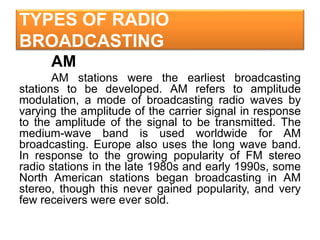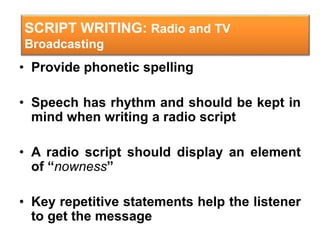My Report
- 2. News reporting involves discovering all relevant facts, selecting and presenting the important facts and weaving a comprehensive story. Reporting involves hard work, which in turn involves stamina and patience. The main function of journalistic profession is news reporting. A reporter needs not only energy to spend long hours chasing a story, collecting facts from various sources in an effort to dig up the truth, he needs must have the will to pursue the course of his investigation to the very end in order to produce a really comprehensive story without any missing links or unanswered questions. News Reporting
- 3. TYPES OF NEWS REPORTING
- 4. TYPE OF NEWS REPORTING There are different types of news reporting which are as under: âĒ Investigative Reporting âĒ Court Reporting âĒ Accidence Reporting âĒ Political Reporting âĒ Fashion Reporting âĒ Business Reporting âĒ Sports Reporting âĒ Specialized Reporting
- 5. 2 KINDS OF NEWS REPORTING
- 6. 1st: RADIO Broadcasting Radio broadcasting is transmission by radio waves intended to reach a wide audience. Stations can be linked in radio networks to broadcast a common radio format, either in broadcast syndication or simulcast or both. Alternatives to terrestrial radio broadcasting include cable radio, local wire television networks, satellite radio, and internet radio via streaming media on the Internet. The signal types can be either analog audio or digital audio.
- 8. TYPES OF RADIO BROADCASTING AM AM stations were the earliest broadcasting stations to be developed. AM refers to amplitude modulation, a mode of broadcasting radio waves by varying the amplitude of the carrier signal in response to the amplitude of the signal to be transmitted. The medium-wave band is used worldwide for AM broadcasting. Europe also uses the long wave band. In response to the growing popularity of FM stereo radio stations in the late 1980s and early 1990s, some North American stations began broadcasting in AM stereo, though this never gained popularity, and very few receivers were ever sold.
- 9. TYPES OF RADIO BROADCASTING FM FM refers to frequency modulation, and occurs on VHF airwaves in the frequency range of 88 to 108 MHz everywhere except Japan and Russia. Russia, like the former Soviet Union, uses 65.9 to 74 MHz frequencies in addition to the world standard. Japan uses the 76 to 90 MHz frequency band.
- 10. CREW OF A RADIO BROAD PRODUCTION on stage and production âĒ ANCHOR âĒ REPORTERS âĒ DIRECTOR âĒ TIMER(ASSISTANT DIRECTOR) âĒ TECHNICAL DIRECTOR âĒ SCRIPT WRITER âĒ INFOMERCIALIST âĒ PRODUCTION
- 11. 2nd: TELEVISION Broadcasting Terrestrial or broadcast television is a type of television broadcasting in which the television signal is transmitted by radio waves from the terrestrial (Earth based) transmitter of a television station to a TV receiver having an antenna. The term "terrestrial" is used to distinguish this type from the newer technologies of satellite television, in which the television signal is transmitted to the receiver from an overhead satellite, and cable television, in which the signal is carried to the receiver through a cable. It has the duty same as to radio broadcasting to transmit information to the listeners through these media.
- 13. CREW OF A TV BROAD PRODUCTION âĒ ANCHOR âĒ NEWS FIELD REPORTERS âĒ DIRECTOR âĒ VTR OPERATOR âĒ TECHNICAL DIRECTOR âĒ SCRIPT WRITER âĒ CAMERA MAN âĒ INFOMERCIALIST TEAM âĒ TRANSMISSION CONTROL MEN âĒ ETCâĶ
- 14. SCRIPT WRITING
- 16. âĒ Type copy in big letter so the newscaster can easily read it. âĒ All spoken lines should be typed in big and small letters. âĒ All instructions and non-spoken lines should be typed in big or capital letters. âĒ Have a duplicate of each copy. âĒ Make each sentence a paragraph. âĒ Write a page number on each script. âĒ End each page with a paragraph before using another paper. SCRIPT WRITING: Radio and TV Broadcasting
- 17. SCRIPT WRITING: Radio and TV Broadcasting âĒ Make your script clean. âĒ Mark âxâ for erroneous word. âĒ Make the script short and simple. âĒ Do not use words which are hard to pronounce. âĒ Donât text-write. âĒ Each sentence should not exceed 12 words. Break down long sentences for easy readability. âĒ Attribute the source of your story either at the beginning or at the end of your news.
- 18. SCRIPT WRITING: Radio and TV Broadcasting Round-off figures/numbers âĒ Change 2.6123 million to more than 2 and a half million âĒ 35.7002 percent to nearly 36 percent SAMPLE Umabot sa may 10.349 milyong pisoâĶ Umabot sa mahigit sampung milyong pisoâĶ Write out symbols and fractions Avoid abbreviations Other reminders
- 19. SCRIPT WRITING: Radio and TV Broadcasting Keep subject and verb close together and use active rather than the passive voice for verb, Sample Wrong: Ang naganap na sunud-sunod na nakawan sa mga paaralan ay pinasisiyasat ni Tarlac City Mayor Aro Mendoza. Correct: Pinasisiyasat ni Tarlac City Mayor Aro Mendoza ang naganap sunud sunod na nakawan sa mga paaralan Sentence Structure
- 20. SCRIPT WRITING: Radio and TV Broadcasting âĒ Provide phonetic spelling âĒ Speech has rhythm and should be kept in mind when writing a radio script âĒ A radio script should display an element of ânownessâ âĒ Key repetitive statements help the listener to get the message
- 22. GUIDELINES WHEN WRITING A BROADCAST SCRIPT: Radio and TV Broadcasting âĒ Read your story out loud. Even if you read it softly, read as if you were saying the story on air. See if it would make sense to someone hearing it for the first time. âĒ Avoid jargon. Police use such phrases as "fled on foot" or "lacerations," but you don't have to include jargon in your script. A story should sound as though you were speaking to someone in conversation. You honor journalism's standards of clarity when you translate jargon into simple, everyday language. âĒ Use active voice. Think "who did what?" to create active, strong sentences. Scripts written in passive voice can be less interesting to your audience, they are awkward to read, and they tend to be longer. âĒ Write to your video. Video enriches the story your viewers see. Use it to put your audience at the scene and then use the script to explain what they are not seeing. âĒ Hook your audience. When you're writing a tease or a lead, ask: Will this make people want to stay around for this story? Does it give too much of the story away?
- 23. END






















